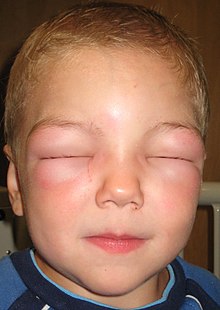Signs and Symptoms
- Swelling of the face, tongue, larynx, abdomen, or arms and legs
- Associated with hives or urticaria
- Onset typically over minutes to hours
- May cause itching or pain
- Severe cases can lead to respiratory distress and require intubation
Causes and Triggers
- Allergic reaction to agents such as insect bites, foods, or medications
- C1 esterase inhibitor deficiency, angiotensin-converting enzyme inhibitors, or lymphoproliferative disorder
- Idiopathic or weakly correlated to allergen exposure
- Hereditary angioedema often has no identifiable cause
- Triggers can include infections, minor injuries, mechanical irritation, operations, or stress
Pathophysiology
- Histamine or bradykinin are involved in the underlying mechanisms
- Histamine-related angioedema is allergic in nature
- Bradykinin-related angioedema is caused by C1 esterase inhibitor deficiency or medication
- Bradykinin is a potent vasodilator and increases vascular permeability
- ACE inhibitors block the degradation of bradykinin
Diagnosis
- Clinical picture and medical history are important for diagnosis
- Routine blood tests are performed to assess overall health
- Mast cell tryptase levels may be elevated in allergic reactions
- Complement levels, especially depletion of complement factors 2 and 4, may indicate C1-inhibitor deficiency
- HAE type III is diagnosed by excluding other causes and observing angioedema with normal C1 levels and function
Treatment
- Protection of the airway may require intubation or cricothyroidotomy
- Antihistamines, corticosteroids, and epinephrine can be used for histamine-related angioedema
- C1 esterase inhibitor, ecallantide, or icatibant may be used for bradykinin-related angioedema
- Fresh frozen plasma can also be used as a treatment
- Treatment should be tailored to the underlying cause and severity of the angioedema
Acquired Angioedema
- Can be immunologic, nonimmunologic, or idiopathic
- Usually caused by allergy and occurs with other allergic symptoms and urticaria
- Can be a side effect of certain medications, especially ACE inhibitors
- Characterized by repetitive episodes of swelling in various body parts
- Edema of the gastrointestinal mucosa can cause severe abdominal pain and in the upper respiratory tract, it can be life-threatening
Hereditary Angioedema
- Exists in three forms caused by genetic mutations
- Types I and II caused by mutations in the SERPING1 gene
- Type III linked with mutations in the F12 gene
- All forms lead to abnormal activation of the complement system
- Can cause swelling in various parts of the body, including the digestive tract and larynx, which can be life-threatening
Management
- Allergic angioedema can be prevented with avoidance of allergens and antihistamines
- Severe cases may require desensitization or steroid therapy
- Drug-induced angioedema caused by ACE inhibitors should be treated by discontinuing the drug and finding an alternative treatment
- Hereditary angioedema does not respond to antihistamines, corticosteroids, or epinephrine
- Acute treatment for hereditary angioedema includes C1-INH concentrate or fresh frozen blood plasma
Acquired Angioedema Treatment
- Antifibrinolytics such as tranexamic acid or ε-aminocaproic acid may be effective
- Cinnarizine can be useful in patients with liver disease
- Androgens like danazol, oxandrolone, or methyltestosterone can prevent future attacks of HAE
- Lanadelumab, an injectable monoclonal antibody, can prevent attacks of HAE types I and II
- Icatibant and ecallantide are medications that may be used to treat attacks of hereditary angioedema
Epidemiology
- In the U.S., there are 80,000 to 112,000 emergency department visits for angioedema annually
- Angioedema ranks as the top allergic disorder resulting in hospitalization
- The exact prevalence of angioedema is unknown
- Acquired angioedema is more common than hereditary angioedema
- Hereditary angioedema affects approximately 1 in 50,000 people
Complications and Prevention of Angioedema
- Potential airway obstruction leading to respiratory distress or asphyxiation
- Recurrent episodes of angioedema can significantly impact quality of life
- Prevention strategies include avoiding known triggers and allergens
- Genetic counseling and testing for individuals with hereditary angioedema
- Education and awareness about angioedema and its potential complications
Angioedema is an area of swelling (edema) of the lower layer of skin and tissue just under the skin or mucous membranes. The swelling may occur in the face, tongue, larynx, abdomen, or arms and legs. Often it is associated with hives, which are swelling within the upper skin. Onset is typically over minutes to hours.
| Angioedema |
|---|
| Other names | Angiooedema, Quincke's edema, angioneurotic edema |
|---|
 |
| Allergic angioedema: this child is unable to open his eyes due to the swelling. |
| Specialty | Allergy and immunology, emergency medicine |
|---|
| Symptoms | Area of swelling |
|---|
| Usual onset | Minutes to hours |
|---|
| Types | Histamine mediated, bradykinin mediated |
|---|
| Risk factors | Family history |
|---|
| Diagnostic method | Based on symptoms |
|---|
| Differential diagnosis | Anaphylaxis, abscess, contact dermatitis |
|---|
| Treatment | Intubation, cricothyroidotomy |
|---|
| Medication | Histamine: antihistamines, corticosteroids, epinephrine
Bradykinin: C1 esterase inhibitor, ecallantide, icatibant, fresh frozen plasma |
|---|
| Frequency | ~100,000 per year (US) |
|---|
The underlying mechanism typically involves histamine or bradykinin. The version related to histamine is due to an allergic reaction to agents such as insect bites, foods, or medications. The version related to bradykinin may occur due to an inherited problem known as C1 esterase inhibitor deficiency, medications known as angiotensin-converting enzyme inhibitors, or a lymphoproliferative disorder.
Treatment to protect the airway may include intubation or cricothyroidotomy. Histamine-related angioedema can be treated with antihistamines, corticosteroids, and epinephrine. In those with bradykinin-related disease a C1 esterase inhibitor, ecallantide, or icatibant may be used. Fresh frozen plasma may be used instead. In the United States the disease affects about 100,000 people a year.
English
Alternative forms
- angioœdema, angio-œdema
- angiooedema, angio-oedema
- angio-edema
Etymology
angio- + edema
Pronunciation
- IPA(key): /ˌænd͡ʒiəʊ.ɪˈdiːmə/
Noun
angioedema (usually uncountable, plural
...
Read More
